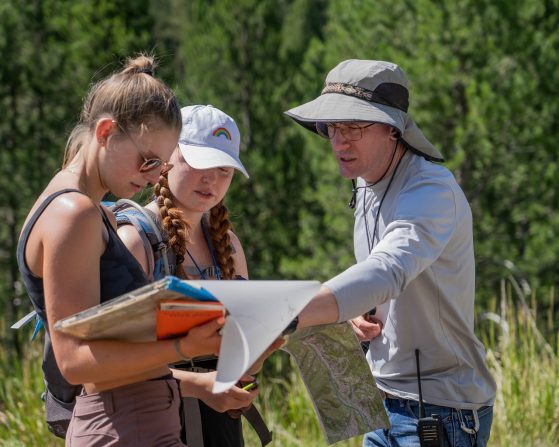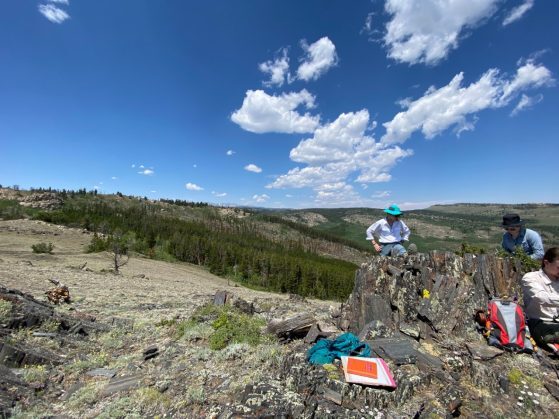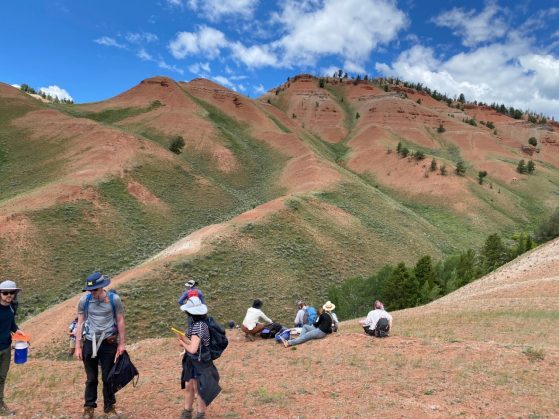
Asst. Prof. Robert Holder with students in the field, July 2021
In a digital dispatch from Camp Davis one recent Thursday evening in July, Professor Nathan Niemi, the field station’s director, discussed what life at camp looks like 15 months after the onset of the COVID-19 pandemic disrupted field research, and how the camp has adapted each step of the way since March 2020.
Camp Davis faculty and staff were excited to welcome students back to Jackson this summer to fully enjoy the results of the largest renovation in camp history. The cabins, newly built in 2019, are complete with private bathrooms, noted graduating senior Savannah McDowell, an Earth and Environment major, who attended Camp Davis for the second time this summer and remembers staying in the more primitive accommodations. The new Rec Hall, built to replace Johnston Hall which collapsed during an ice storm in 2018, offers students a place to gather during downtime (for camp favorites like ping pong, foosball, pool, and movie nights), as well as modernized classroom and teaching space.
A major upgrade has been the installation of fiber optic internet, enabling a host of exciting new research and teaching opportunities previously impossible in the field setting, including real-time connection back to campus labs, development of virtual thin sections, and GIS and Google mapping.
Of course, noted Niemi, some things at Camp Davis haven’t changed; the kitchen staff, under Aaron Bruner’s direction for the eleventh year, is producing delicious meals for ravenous students (“Camp Davis is the only field camp where you actually gain weight,” said Niemi); the flagpole still stands tall in the center of camp; and the old dining hall is the last piece of critical infrastructure that remains to be replaced or renovated.
The 2020 Virtual Experiment
In an effort to figure out how to best engage students during a remote year, Camp Davis faculty, including Niemi, joined 300 other geoscientists nationwide to contribute to a white paper and resource website, Designing Remote Field Experiences for Students, coordinated by the National Association of Geoscience Teachers, about the fundamental goals and tasks of field camp for students. Virtual field exercises were developed and shared to the community by Camp Davis faculty member John Geissman (B.S. 1973, M.S. ’76, Ph.D. ’80), Earth faculty member Ben van der Pluijm, and Earth and Camp Davis alumni, including Alison Duvall (Ph.D. ’11).
When the flurry of initial pandemic activity settled, Niemi discovered that most U-M Earth majors were opting to postpone field camp to 2021, when they expected they’d be able to return to Camp Davis in person. The exceptions were primarily graduating seniors who needed field camp credits to complete their undergraduate degrees in 2020. Camp Davis also has a long history of offering courses at the introductory level, as well as courses for non-majors. Demand for virtual versions of these courses was high in spring term 2020, but waned through the summer of 2020 as other activities became available to students. Ultimately, Camp Davis offered only a spring session in 2020; demand for virtual classes had dropped sharply by summer.
To meet the course needs of graduating seniors in 2020, instructors from upper level courses banded together to offer one virtual course, and those leading lower level courses did the same. Graduate students taught instructors how to use social media tools to build community virtually, and instructors devised creative plans to bring as much of Camp Davis’s blend of inclusivity, fun, and wonder to the virtual classroom as they could.
Faculty from the upper level course sent care packages to their students across the country, which included field notebooks, USB thumb drives with reading materials, scientific sampling equipment, and other field supplies to enable students to do field work in their own backyards. And Niemi and Geissman, hoping to capitalize on the diversity of regional environments, asked the students in their course to go out and find a rock from wherever they were for an impromptu identification session. It made for some unforgettable science, when the faculty were put on the spot to identify rocks from around the country via webcam, and a student found a rock in Toledo that Geissman and Niemi could only surmise had been shipped there for landscaping purposes from somewhere far to the west (maybe New Mexico?).
2021: The Careful Return to Camp
Unsure of what kinds of surprises this spring might bring, whether vaccinations would be widely available, and how travel might be affected, the Camp Davis team began planning for any eventuality in fall 2020. They were delighted to discover that students and instructors could return to camp together in 2021, albeit with COVID guidelines and restrictions from the U.S. government, the state of Wyoming, and the university.
Due to pent up student demand for in-person experiences and COVID-related capacity and social distancing guidelines (primarily in indoor spaces like the dining hall), lengthy waitlists formed for this season’s Camp Davis courses. Only one course can be taught at Camp per session, so camp is offering three sections of major courses, two sections of Earth 450 (Ecosystem Science) and one section of Earth 440 (Field Geology). By the end of the summer, 65 students will have deepened their interest and understanding in field research and collected a host of favorite camp experiences—like visiting the Atlantic City banded iron formations, gazing at the Red Hills, finding trilobites on Rendezvous Mountain, or visiting the rhyolite domes that protrude through the basalt at Island Park.
“Teaching field geology has been very close to my heart since I began teaching as a graduate student, so it was great to be out in the field with a class again,” noted assistant professor Robert Holder, new to the department and teaching at Camp Davis for the first time. “Field camp is an amazing opportunity for students to bring together everything they have learned in their other classes and it teaches valuable, transferable professional skills.”
In his own research, Holder, a petrologist, studies the development of modern and ancient mountain belts and how the continents have changed through time. “What is particularly amazing about Camp Davis is that the students get to look at geology from the Archean to the last ice age, and they think deeply about how Earth has changed through time,” he said.
“There is no substitute for physically standing on deposits from hundreds of millions of years ago, seeing the minerals and thinking about what might have happened. It’s like being a history detective, visualizing how the area, and the world has changed,” said Trent Stegink, a rising senior in Earth and Environmental Sciences who is taking his first course at Camp Davis this summer. “Plus mapping and structural geology are just a lot easier to learn in person.”

“Going out into the field helps you pick up the storyline of the planet’s formation, like ‘this piece of limestone was under water, now it’s in the mountains,’” Savannah agreed. “The technical skills that we’re developing build upon each other with each new trip to the different areas around camp.”
“Whether or not a student’s eventual career is in the sciences or a technical field, the numerous skills that field research develops will help them be successful. It trains you to think spatially, manage your time efficiently, draw inferences from limited observations, make a plan of action—or change direction—while you are in the middle of the action, work cooperatively with partners, and report what you’ve learned even when you might feel like you haven’t had enough time to complete that learning,” Niemi continued. “We discovered in 2020 that we can deliver on the core competencies of field research remotely and are proud of the outcome, but nothing compares to being here in the outdoor classroom.”
Like many students who’ve attended Camp Davis to study some of the most scenic and interesting geology, history, and ecology in the Rocky Mountain region, Trent and Savannah relied on scholarship support to make their experience at the field station possible this summer. Donor support is crucial to providing access for all students to Camp Davis’s unparalleled undergraduate field experiences and research opportunities.
“Without the financial aid I received to attend camp, I did not know how I would finish my degree. I’m extremely grateful to the donors,” said Savannah.

Update from the Chair of the Department of Earth and Environmental Sciences
“I had the pleasure of joining Nate last week in Camp Davis,” said EES Chair Marin Clark. “And it was so exciting and just so normal to be back, on the trail to Rendezvous Mountain, talking about the Paleozoic passive margin sediments with a group of enthusiastic 440 students.”
Clark joined the event from her office on campus in Ann Arbor, to which she’d recently (and perhaps reluctantly) returned, to give an overview of the department as it rolls out its new ten year strategic plan. The plan supports and expands the department’s growth since 2010 when the department changed its name from Geological Sciences to EES. The makeup of the department has changed considerably since that time, and it has expanded both in size and scope.
As professors have retired, many associate and assistant professors have been hired; this fall, the department will have a record-setting 33 tenure track professors. The graduate program remains strong, with about 70 students who have recently begun to connect more directly with alumni through career panels and career advising. Undergraduate majors now number 189 (another department record!), driven largely by their interest in some of EES’s newer fields, climate, geobiology and environmental science—“all of which complement our well-known strengths in geology, geochemistry, paleontology and geophysics,” noted Clark.
The strategic planning process identified five research priorities: water, climate, ecosystems & biogeochemistry, Earth’s surface and its hazards, life and the rock record, and solid earth dynamics.
“These research directions are our assessment of how we can advance our department mission, build a stronger and more cohesive unit and accelerate our research programs,” said Clark. “What’s exciting is how much these themes intersect and connect our department in new ways, including the connections we make to one another and to other units on campus in our research spaces.”
To learn more:
Learn more about how to support the Department of Earth and Environmental Sciences.


